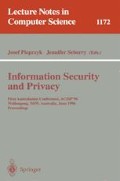Abstract
We investigate irrational numbers as a source of pseudorandom bits. We suggest two secure pseudorandom bit generators based on transcendental numbers. These two classes of transcendentals are applied to construct novel encryption algorithms. Properties of the encryption algorithms are studied and preliminary cryptanalysis is given.
Support for this project was provided in part by the Australian Research Council under the reference number A49530480 and the ATERB grant
Preview
Unable to display preview. Download preview PDF.
References
A. Baker. Transcendental Number Theory. Cambridge University Press, 1975.
M. Blum and S. Micali. How to generate cryptographically strong sequences of pseudo-random bits. SIAM Journal on Computing, 13:850–864, November 1984.
E. Borel. Lecons sur la Theorie des Fonctions. 2nd Ed, 1914,pp.182–216.
R.L. Burden and J.D. Faires. Numerical Analysis. PWS Publishing Company, Boston, 1993.
H. Feistel. Cryptography and computer privacy. Scientific American, 228(5):15–23, 1973.
M. R. Garey and D. S. Johnson. Computers and Intractability A Guide to the Theory of NP-completeness. W.H. Freeman and Company, 1979.
R. Kannan, A.K. Lenstra, and L. Lovász. Polynomial factorization and nonrandomness of bits of algebraic and some transcendental numbers. Mathematics of Computation, 50:235–250, 1988.
D.E. Knuth. The Art of Computer Programming, Volume 2. Addison-Wesley, 1981.
H.W. Lenstra, A.K. Lenstra, and L. Lovász. Factoring polynomials with rational coefficients. Math. Ann., 261:513–534, 1982.
R.L. Rivest Cryptography Handbook of Theoretical Computer Science, Chap. 13 Edited by J. van Leeuwen Elsevier Science Publishers, 1990.
A. Schönhage. The fundamental theorem of algebra in terms of computational complexity. Preliminary report, Mathematisches Institut der UniversitÄt Tübigen, August 1982.
A. Shamir. On the generation of cryptographically strong pseudo-random sequences. ACM Transactions on Computer Systems, 1(1):38–44, 1983.
J.S. Vandergraft. Introduction to Numerical Computations. Academic Press, New York, 1983.
Andrew C. Yao. Theory and application of trapdoor functions. In Proceedings of the 23rd IEEE Symposium on Foundation of Computer Science, pages 80–91, New York, 1982. IEEE.
Author information
Authors and Affiliations
Editor information
Rights and permissions
Copyright information
© 1996 Springer-Verlag Berlin Heidelberg
About this paper
Cite this paper
Pieprzyk, J., Ghodosi, H., Charnes, C., Safavi-Naini, R. (1996). Cryptography based on transcendental numbers. In: Pieprzyk, J., Seberry, J. (eds) Information Security and Privacy. ACISP 1996. Lecture Notes in Computer Science, vol 1172. Springer, Berlin, Heidelberg. https://doi.org/10.1007/BFb0023291
Download citation
DOI: https://doi.org/10.1007/BFb0023291
Published:
Publisher Name: Springer, Berlin, Heidelberg
Print ISBN: 978-3-540-61991-8
Online ISBN: 978-3-540-49583-3
eBook Packages: Springer Book Archive

